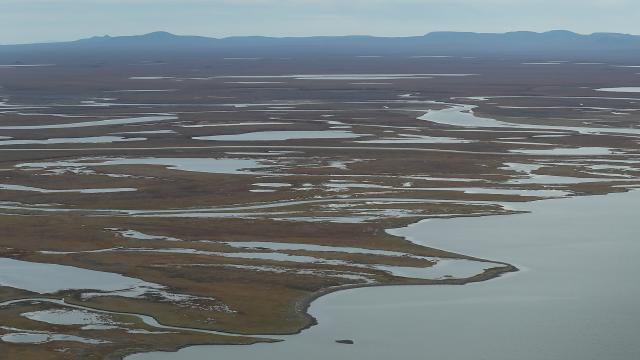Scientists have long assumed that a thick, solid mass of permafrost underpins all of Alaska like the sturdy foundation of a house, stretching from the tundra to the and below the seafloor. But in a new study published in Science Advances, scientists found that beneath the seafloor on the northeastern coast of Alaska, there’s barely any permafrost.
That raises the possibility that permafrost — permanently frozen ground made of soil, rocks, and water±will melt much, much faster as the planet warms, which in turn could release more carbon dioxide into the atmosphere.
The new research focuses on Kaktovik Lagoon, a bay on Alaska’s northeastern coast. To check for permafrost beneath the bay’s seafloor, beach, and nearby tundra ecosystems, they used an electrode-based geophysical method called electrical resistivity imaging, which allowed them to produce an image of the seafloor and the area beneath it. The process took multiple trips over three years. What they found was troubling. The image they generated showed that in the 20 metres below the area lagoon’s seafloor and beach, there was no ice at all.
Even more surprising, when the authors checked for permafrost below the tundra’s soil, they found that there was icy permafrost in the 4.9 metres below it, but below that, there was also no ice. This contradicts with previous models which assumed the depths contained a much thicker and therefore more durable layer.
“This study tells us that the coastline is much more complicated than we thought,” study co-author Jim McClelland, a professor at the University of Texas’ Marine Science Institute, said.
Scientists have long warned that permafrost melting amid the climate crisis would unlock untold amounts of carbon which could trigger a level of global warming the world has never seen. Globally, permafrost contains 1,600 gigatons of planet-warming carbon, which is nearly twice the amount the in the atmosphere. The melting of this frozen ground has already been linked to rising carbon emissions in the Alaskan tundra. Findings released last year show that permafrost is now releasing more carbon dioxide than it’s taking up in the Arctic.
If the permafrost beneath Alaska isn’t a single thick mass like scientists previously thought, it could spell even bigger trouble down the road. A small, thin ice cube will melt faster than a large one, and the same is true of permafrost. The lack of ice beneath the layer of permafrost under the tundra also raises the possibility for liquid groundwater to slosh against it, melting it while carrying its carbon to different parts of Alaska as the water moves.
“It opens up the possibility for routes of water exchange that we weren’t thinking about,” McClelland said.
In another complication, some bodies of water in Alaska are filled with saltwater, while others are filled with freshwater. Without permafrost to prevent its flow, the researchers are concerned that saltwater can move underneath the tundra into freshwater sources, wreaking havoc on delicate, at-risk ecosystems.
Quicker permafrost melt could also mean faster coastline erosion, which could threaten the homes of Inupiat Indigenous communities in the Kaktovik region as well as millions of others living in the Arctic.
